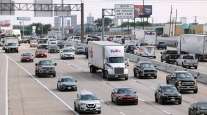Washington, Baltimore Expecting up to 2 Feet of Snow
A blizzard watch goes into effect Jan. 22 into Jan. 23 for parts of Virginia and Maryland, including Washington and Baltimore, the National Weather Service said. High winds and heavy snow could make travel difficult and create life-threatening conditions.
“One to two feet is probably a good bet at this point, with locally higher amounts,” said Rick Otto, a meteorologist with the U.S. Weather Prediction Center in College Park, Maryland. “The locations of Boston and New York are kind of in the iffy section of the snowfall.”
Our Fri-Sun snowfall forecast (below) and everyone else's. Compilation here: https://t.co/FJsV9efFYT pic.twitter.com/PhXHXsVdWl
— Capital Weather Gang (@capitalweather) January 20, 2016 Elsewhere in the country, the severe weather was already having an impact.
• In Louisville, UPS said severe weather was causing a significant disruption at its Worldport distribution hub, and some shipments may experience unavoidable delays.
• Northeast Georgia residents were bracing for snow and ice on Jan. 20. A Georgia Department of Transportation spokesperson said, "You see our trucks on the road, give them plenty of room so they can apply the brine mixture and we don't want any rocks to hit your windshield."
• Highway officials in Maryland are making preparations to try to keep roads cleared. (CBSBaltimore.com video)
• Philadelphia is expecting 12 to 16 inches of snow.
A blizzard would eliminate a snow drought that has plagued many of the East Coast’s largest cities this winter. New York has only received 0.4 inch, or 8.6 inches fewer than normal, the weather service said. Philadelphia, Washington and Baltimore are all inches behind an average season and Boston is more than a foot below the 30-year average.
Otto said forecasts are harder for the area north of Philadelphia because there’s expected to be a fine line between where snow falls and it doesn’t. According to one model, for instance, Boston will get nothing, while another shows the city getting 2 to 4 inches.
In New York, the northern areas of the city probably will get less, while Staten Island could get as much as a foot, he said.
“We’re still a couple of days out, and I guarantee the models will waver and shift,” Otto said.
The highest confidence is that Washington and Baltimore won’t escape a heavy snowfall.
“The worst of it is probably going to be in Washington, D.C., and Baltimore,” said Gary Best, a meteorologist at Hometown Forecast Services Inc. in Nashua, New Hampshire. “The worst of the storm will be [Jan. 22 into Jan. 23]."
Best said the snow will start between 1 and 4 p.m. EST in Washington and Baltimore and just a little later in Philadelphia.
“For the afternoon commute, it will be snowing,” Best said. “In D.C., Baltimore and even Philly, if you are working [Jan. 22], leave as early as you can.”
Airlines prepare for delays, cancellations ahead of Winter Storm #Jonas. Get the details: https://t.co/FGhAqQ4j1T pic.twitter.com/G6oR0nq4RR
— The Weather Channel (@weatherchannel) January 20, 2016
In New York, rain could mix with the snow and hold down accumulations, said Tom Kines, a meteorologist with AccuWeather Inc. in State College, Pennsylvania. The city will start to get snow late Jan. 22 into the morning of Jan. 23.
If the storm’s track changes at all, then the accumulation outlooks for cities such as New York and Boston could shift significantly in either direction, he said.
Along with the snow, there will high winds along the coast that could lead to beach erosion as the storm passes out to sea, Kines said.



